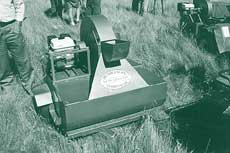
Methods of seed harvesting
Non-mechanical methods
Hand harvesting is an arduous task and seed yields are low. It can be the only feasible method of seed collection when a plant is rare, of limited local occurrence or in an inaccessible area. Seed heads can be individually cut off or seed stripped from the inflorescence (Inflorescence - a group of flowers borne on a stem) by running a hand from the base of the inflorescence upwards. In some cases (e.g. T. triandra), seed has been harvested by cutting the entire stem (culm - a grass stem), and allowing the seed to mature in the head and be shed over time. In such cases culms can be transported to the revegetation site immediately following harvest.
Conventional mechanical harvest techniques
It is the unique seeding characteristics of native grasses that make seed harvesting difficult using conventional direct harvesting methods. Exceptions includeAstreblaandElymusthat have a high degree of seed retention and can therefore be harvested using conventional machinery. SomeAustrodanthoniaspp. also have a high degree of seed retention but are unsuited to direct heading because of the light fluffy nature of their seed. Windrowing followed by threshing the dry crop has been used with limited success to harvest seed from these species.
Trough, beater and brush harvesting
The light, chaffy nature of native grass seed lends itself to beater, and in particular, brush harvesting techniques. Trough and later beater harvesters were developed in Queensland to collect seed from Heteropogon contortus (black spear grass) and the exotic grass, Cenchrus ciliaris (buffel grass). In their simplest form, trough harvesters are simply a trough fixed on the front of the vehicle at an appropriate height. As the vehicle is driven through the crop ripe seeds fall into the trough while immature seeds remains on the plant to be harvested later. Troughs are not effective for species with light and fluffy dispersal units as they tend to blow out of the trough.
The brush harvester has proven to be the most useful harvesting technique for a wide range of grass species. This is a non-destructive harvesting technique that allows for multiple harvests of a stand of grass. In this way it overcomes some of the difficulties by removing ripe seed only resulting in increased yields of viable seed.
The original concept of the brush harvester comes from an American design, the Woodward Flail-Vac Seed Stripper that was developed in the early 1980Õs. The central concept of the brush harvester is a flailing brush which rotates upwards at its leading edge. This design has meant fewer stems are broken during harvest, as well as a cleaner product compared with conventional direct heading methods. A metal shroud over the brush creates a cross flow fan action that generates sufficient air velocity to gather seed heads into the flailing brush. The shroud also directs the flow of air and seed into a wedge-shaped seed hopper behind the brush. The triangular shape of the seed collection bin reverses the direction of airflow, depositing the seed into a dead air space on the floor of the bin while air escapes through the exit vent. These various components are illustrated in Figure 1.
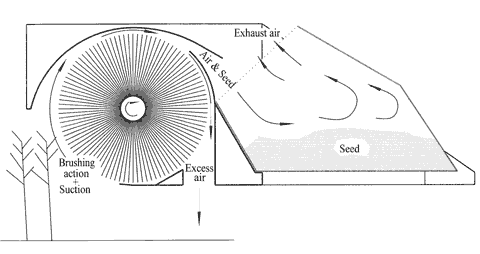
Subsequent Australian adaptations of the original American brush harvester have seen a number of designs available commercially in recent years. One such machine, the 'Trangie brush harvester', designed and built by NSW Agriculture, can be towed behind any vehicle and has adjustable harvest height and brush speeds (Picture 2). Another more mobile adaptation, 'The grasshopper' designed by DLWC is easily serviced and has manual harvest height adjustment (Picture 3). Brush harvesters need not be large and a small hand-held brush harvester has been designed and build in Queensland by Grass Seeds Australia, Darling Downs (Picture 4).
Picture 2. The user friendly 'Trangie brush harvester' has an adjustable brush speed and harvest height as well as a seed bin that can be automatically emptied. (Photograph C. Waters)
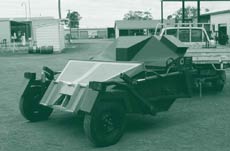
Picture 3. The DLWC 'Grasshopper' is light weight (500–750 kg), has adjustable brushes and harvest height. The 'off-set' working position facilitates harvesting ripe seed that has not been disturbed by the towing vehicle. (Photograph C. Huxtable)
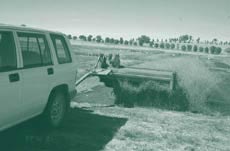
Picture 4. A hand held brush harvester designed to collect seed from small, inaccessible areas. (Photograph I. Cole)
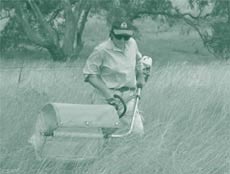
Picture 5. A reel and brush harvester which gathers culms with inflorescences over the top of a rotating brush to deposit the seed in a seed hopper. Designed and built by J. Stafford, Vegetation Management Services, Main Rd, Lenswood. SA 5240 (Photograph R. Whalley)
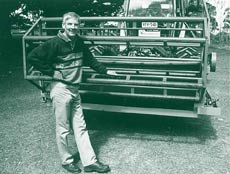
Suction or vacuum harvesting
The dispersal units of some native grasses (e.g. M. stipoides) are very easily removed from the inflorescences, even when they are in the early stages of development. Hand-held commercial outdoor vacuum cleaners can be used to harvest this type of seed and tend to remove only mature seed.
Vacuum cleaners are only suitable for harvesting small areas because the intake is quite small (say 12 cm x 8 cm) (Picture 6).
Picture 6. An electric garden vacuum cleaner can be used successfully to harvest small areas of M. stipoides. (Photograph C. Waters)
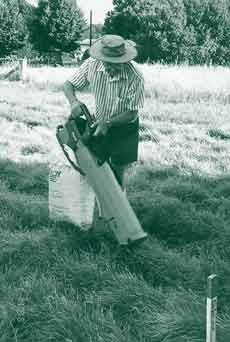
The success of these hand-held machines stimulated inventive groups of farmers to develop small vacuum harvesters with a wider intake (about 1 m wide) for harvesting larger areas of native grass seed. One of these, 'The Scorpion', is self-propelled and was designed and constructed by members of the Barney's Reef Landcare Group (Picture 7).
Picture 7. The ‘Scorpion’ vacuum harvester, designed for harvesting native grass seed and built by members of the Barney’s Reef Landcare Group in collaboration with DLWC and Rosevale Engineering, Gulgong. (Photograph R. Whalley)
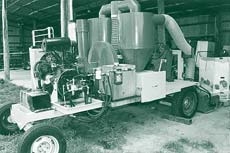
A final modification to this machine includes a combination of vacuum and brush (Picture 8).
Picture 8. The ‘Rosevale Reaper’ is a re-design of the original ‘Scorpion’ allowing for the harvester to be utility mounted and easily transported. (Photograph I. Cole)
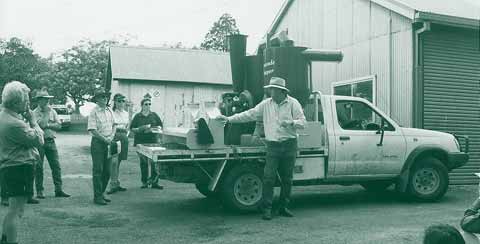
A second suction harvester, 'The Bushranger' (Picture 9) grew out of a Community Grasses Project funded by the Murray-Darling Basin Commission and won 2nd prize in the design and construction section at the Australian National Field Days, Orange in 1996. 'The Bushranger' is towed behind a four-wheel motor bike using an offset towbar. It is likely that vacuum harvesters designed for sub-clover and medic seed harvesting could be modified to harvest large areas of native grass seed by removing the threshing drum and modifying the height adjustment.
Picture 9. The ‘Bushranger’ vacuum harvester for native grass seeds was designed and built by John Betts and Tony Wilson of Yass, NSW in a project funded by the Murray-Darling Basin Commission. (Photograph R. Whalley)
